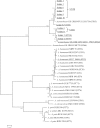Identification, genotypic relation, and clinical features of colistin-resistant isolates of Acinetobacter genomic species 13BJ/14TU from bloodstreams of patients in a university hospital
- PMID: 24403305
- PMCID: PMC3957785
- DOI: 10.1128/JCM.02868-13
Identification, genotypic relation, and clinical features of colistin-resistant isolates of Acinetobacter genomic species 13BJ/14TU from bloodstreams of patients in a university hospital
Abstract
Colistin resistance remains rare among clinical isolates of Acinetobacter species. We noted the emergence of colistin-resistant bloodstream isolates of the Acinetobacter genomic species (GS) 13BJ/14TU from patients at a university hospital between 2003 and 2011. We report here, for the first time, the microbiological and molecular characteristics of these isolates, with clinical features of Acinetobacter GS 13BJ/14TU bacteremia. All 11 available patient isolates were correctly identified as Acinetobacter GS 13BJ/14TU using partial rpoB gene sequencing but were misidentified using the phenotypic methods Vitek 2 (mostly as Acinetobacter baumannii), MicroScan (mostly as A. baumannii/Acinetobacter haemolyticus), and the API 20 NE system (all as A. haemolyticus). Most isolates were susceptible to commonly used antibiotics, including carbapenems, but all were resistant to colistin, for which it is unknown whether the resistance is acquired or intrinsic. However, the fact that none of the patients had a history of colistin therapy strongly suggests that Acinetobacter GS 13BJ/14TU is innately resistant to colistin. The phylogenetic tree of multilocus sequence typing (MLST) showed that all 11 isolates formed a separate cluster from other Acinetobacter species and yielded five sequence types. However, pulsed-field gel electrophoresis (PFGE) revealed 11 distinct patterns, suggesting that the bacteremia had occurred sporadically. Four patients showed persistent bacteremia (6 to 17 days), and all 11 patients had excellent outcomes with cleared bacteremia, suggesting that patients with Acinetobacter GS 13BJ/14TU-associated bacteremia show a favorable outcome. These results emphasize the importance of precise species identification, especially regarding colistin resistance in Acinetobacter species. In addition, MLST offers another approach to the identification of Acinetobacter GS 13BJ/14TU, whereas PFGE is useful for genotyping for this species.
Figures



Similar articles
-
Validation of partial rpoB gene sequence analysis for the identification of clinically important and emerging Acinetobacter species.Microbiology (Reading). 2009 Jul;155(Pt 7):2333-2341. doi: 10.1099/mic.0.026054-0. Epub 2009 Apr 23. Microbiology (Reading). 2009. PMID: 19389786
-
Independent emergence of colistin-resistant Acinetobacter spp. isolates from Korea.Diagn Microbiol Infect Dis. 2009 May;64(1):43-51. doi: 10.1016/j.diagmicrobio.2009.01.012. Diagn Microbiol Infect Dis. 2009. PMID: 19362258
-
A single clone of Acinetobacter baumannii, ST22, is responsible for high antimicrobial resistance rates of Acinetobacter spp. isolates that cause bacteremia and urinary tract infections in Korea.Microb Drug Resist. 2010 Jun;16(2):143-9. doi: 10.1089/mdr.2009.0088. Microb Drug Resist. 2010. PMID: 20370437
-
An Intrinsic Strain of Colistin-resistant Acinetobacter Isolated from a Japanese Patient.Intern Med. 2016;55(16):2301-6. doi: 10.2169/internalmedicine.55.6807. Epub 2016 Aug 15. Intern Med. 2016. PMID: 27523013
-
Colistin-resistant Acinetobacter baumannii: beyond carbapenem resistance.Clin Infect Dis. 2015 May 1;60(9):1295-303. doi: 10.1093/cid/civ048. Epub 2015 Jan 28. Clin Infect Dis. 2015. PMID: 25632010 Free PMC article.
Cited by
-
Emergence of IMP-34- and OXA-58-Producing Carbapenem-Resistant Acinetobacter colistiniresistens.Antimicrob Agents Chemother. 2019 May 24;63(6):e02633-18. doi: 10.1128/AAC.02633-18. Print 2019 Jun. Antimicrob Agents Chemother. 2019. PMID: 30962333 Free PMC article. No abstract available.
-
Update on the Epidemiology, Treatment, and Outcomes of Carbapenem-resistant Acinetobacter infections.Chonnam Med J. 2014 Aug;50(2):37-44. doi: 10.4068/cmj.2014.50.2.37. Epub 2014 Aug 20. Chonnam Med J. 2014. PMID: 25229014 Free PMC article. Review.
-
Risk factors for the first episode of Acinetobacter baumannii resistant to colistin infection and outcome in critically ill patients.J Med Microbiol. 2020 Jan;69(1):35-40. doi: 10.1099/jmm.0.001094. J Med Microbiol. 2020. PMID: 31647404 Free PMC article.
-
High prevalence of oxacillinases in clinical multidrug-resistant Acinetobacter baumannii isolates from the Tshwane region, South Africa - an update.BMC Infect Dis. 2015 Nov 14;15:521. doi: 10.1186/s12879-015-1246-8. BMC Infect Dis. 2015. PMID: 26573617 Free PMC article.
-
Bee products as a source of promising therapeutic and chemoprophylaxis strategies against COVID-19 (SARS-CoV-2).Phytother Res. 2021 Feb;35(2):743-750. doi: 10.1002/ptr.6872. Epub 2020 Sep 18. Phytother Res. 2021. PMID: 32945590 Free PMC article. Review.
References
-
- Nemec A, Musilek M, Maixnerova M, De Baere T, van der Reijden TJ, Vaneechoutte M, Dijkshoorn L. 2009. Acinetobacter beijerinckii sp. nov. and Acinetobacter gyllenbergii sp. nov., haemolytic organisms isolated from humans. Int. J. Syst. Evol. Microbiol. 59:118–124. 10.1099/ijs.0.001230-0 - DOI - PubMed
MeSH terms
Substances
Associated data
- Actions
- Actions
- Actions
LinkOut - more resources
Full Text Sources
Other Literature Sources
Medical

